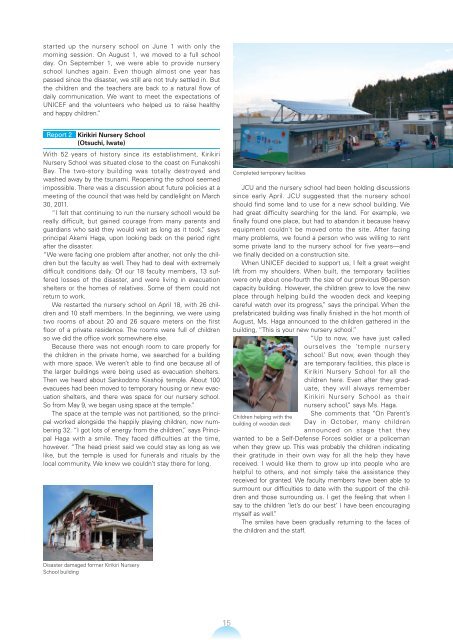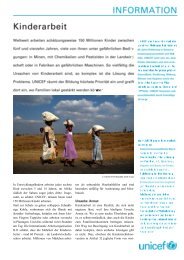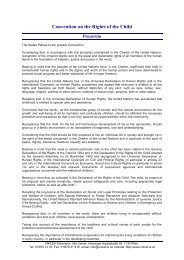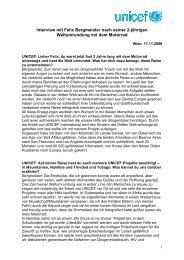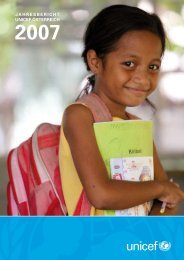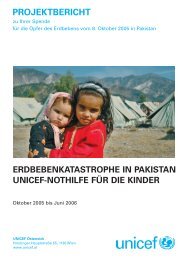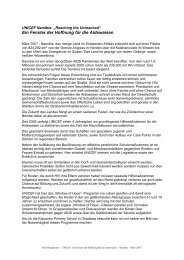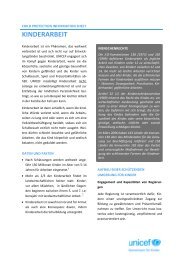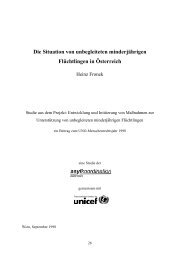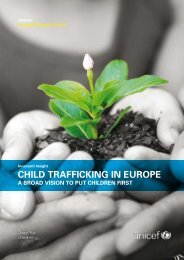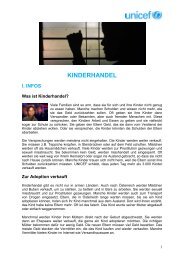Create successful ePaper yourself
Turn your PDF publications into a flip-book with our unique Google optimized e-Paper software.
started up the nursery school on June 1 with only the<br />
morning session. On August 1, we moved to a full school<br />
day. On September 1, we were able to provide nursery<br />
school lunches again. Even though almost one year has<br />
passed since the disaster, we still are not truly settled in. But<br />
the children and the teachers are back to a natural flow of<br />
daily communication. We want to meet the expectations of<br />
UNICEF and the volunteers who helped us to raise healthy<br />
and happy children.”<br />
<strong>Report</strong> 2 Kirikiri Nursery School<br />
(Otsuchi, Iwate)<br />
With 52 years of history since its establishment, Kirikiri<br />
Nursery School was situated close to the coast on Funakoshi<br />
Bay. The two-story building was totally destroyed and<br />
washed away by the tsunami. Reopening the school seemed<br />
impossible. There was a discussion about future policies at a<br />
meeting of the council that was held by candlelight on March<br />
30, 2011.<br />
“I felt that continuing to run the nursery schooll would be<br />
really difficult, but gained courage from many parents and<br />
guardians who said they would wait as long as it took,” says<br />
principal Akemi Haga, upon looking back on the period right<br />
after the disaster.<br />
“We were facing one problem after another, not only the children<br />
but the faculty as well. They had to deal with extremely<br />
difficult conditions daily. Of our 18 faculty members, 13 suffered<br />
losses of the disaster, and were living in evacuation<br />
shelters or the homes of relatives. Some of them could not<br />
return to work.<br />
We restarted the nursery school on April 18, with 26 children<br />
and 10 staff members. In the beginning, we were using<br />
two rooms of about 20 and 26 square meters on the first<br />
floor of a private residence. The rooms were full of children<br />
so we did the office work somewhere else.<br />
Because there was not enough room to care properly for<br />
the children in the private home, we searched for a building<br />
with more space. We weren’t able to find one because all of<br />
the larger buildings were being used as evacuation shelters.<br />
Then we heard about Sankodono Kisshoji temple. About 100<br />
evacuees had been moved to temporary housing or new evacuation<br />
shelters, and there was space for our nursery school.<br />
So from May 9, we began using space at the temple.”<br />
The space at the temple was not partitioned, so the principal<br />
worked alongside the happily playing children, now numbering<br />
32. “I got lots of energy from the children,” says Principal<br />
Haga with a smile. They faced difficulties at the time,<br />
however. “The head priest said we could stay as long as we<br />
like, but the temple is used for funerals and rituals by the<br />
local community. We knew we couldn’t stay there for long.<br />
Disaster damaged former Kirikiri Nursery<br />
School building<br />
15<br />
Completed temporary facilities<br />
JCU and the nursery school had been holding discussions<br />
since early April. JCU suggested that the nursery school<br />
should find some land to use for a new school building. We<br />
had great difficulty searching for the land. For example, we<br />
finally found one place, but had to abandon it because heavy<br />
equipment couldn’t be moved onto the site. After facing<br />
many problems, we found a person who was willing to rent<br />
some private land to the nursery school for five years—and<br />
we finally decided on a construction site.<br />
When UNICEF decided to support us, I felt a great weight<br />
lift from my shoulders. When built, the temporary facilities<br />
were only about one-fourth the size of our previous 90-person<br />
capacity building. However, the children grew to love the new<br />
place through helping build the wooden deck and keeping<br />
careful watch over its progress,” says the principal. When the<br />
prefabricated building was finally finished in the hot month of<br />
August, Ms. Haga announced to the children gathered in the<br />
building, “This is your new nursery school.”<br />
“Up to now, we have just called<br />
ourselves the ‘temple nursery<br />
school.’ But now, even though they<br />
are temporary facilities, this place is<br />
Kirikiri Nursery School for all the<br />
children here. Even after they graduate,<br />
they will always remember<br />
Kirikiri Nursery School as their<br />
nursery school,” says Ms. Haga.<br />
Children helping with the<br />
building of wooden deck<br />
She comments that “On Parent’s<br />
Day in October, many children<br />
announced on stage that they<br />
wanted to be a Self-Defense Forces soldier or a policeman<br />
when they grew up. This was probably the children indicating<br />
their gratitude in their own way for all the help they have<br />
received. I would like them to grow up into people who are<br />
helpful to others, and not simply take the assistance they<br />
received for granted. We faculty members have been able to<br />
surmount our difficulties to date with the support of the children<br />
and those surrounding us. I get the feeling that when I<br />
say to the children ‘let’s do our best’ I have been encouraging<br />
myself as well.”<br />
The smiles have been gradually returning to the faces of<br />
the children and the staff.


